Birds with red breasts are among the most stunning birds you will ever encounter in your life. The red color on their breasts exudes warmth and passion, making you feel good just by seeing them.
What are the different birds with red breasts? There are many birds with red breasts, and among them are the eared quetzal, scarlet ibis, pine grosbeak, red crossbill, and many more. These birds are known for their noticeable red breasts that always stand out from the color of their feathers.
By reading this guide, you will encounter some of the most captivating birds with red breasts. On top of that, you will know their respective characteristics and appearances, so keep on reading!
Table of Contents
18 Birds With Red Breasts
Eared Quetzal
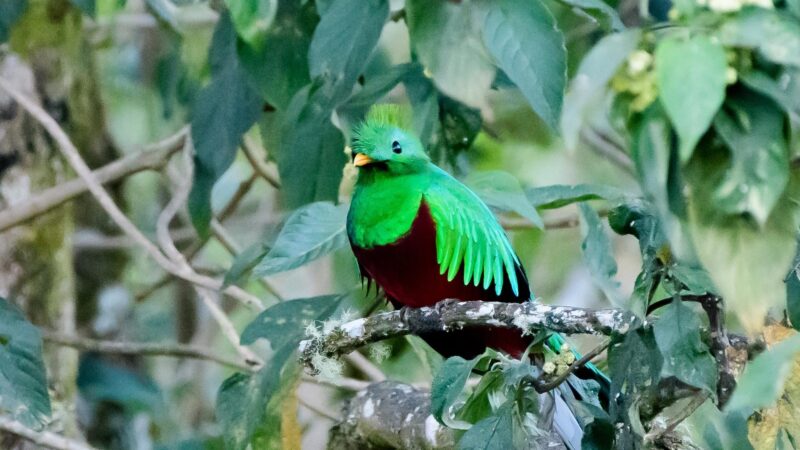
The eared quetzal birds (eared trogon), scientifically known as Euptilotis neoxenus), are close passerine birds in the Trogonidae family.
These birds are native to the canyons and streamside pine-oak forests in Southeastern Arizona in the United States and the Sierra Madre Occidental of Mexico.
These exquisite birds possess an iridescent pop of green, giving them a captivating look. The eared quetzals prefer colder mountainous areas, where they can find and eat many fruits and insects.
If you are thinking of getting these birds as pets, unfortunately, you can’t do so since they react badly when taken in captivity, so it’s best to let them in their natural habitats.
- Appearance: The adult male has a blackish head, iridescent green breast, geranium red belly, and under tail coverts. The adult female has a gray head, breast, and upper abdomen and less extensive (though equally bright) red on the lower stomach.
- Lifespan: 20 years to 25 years
- Body Length: 33 cm to 36 cm (13 inches to 14 inches)
- Weight: 7.1 oz to 7.9 oz (200 grams to 225grams)
- Wingspan: 61 cm
- Color: Golden-green or iridescent green wing coverts, chest, back, and head, with a red belly
- Place of Origin: Western Mexico
- Characteristics: The eared quetzal birds are named after the long postocular plumes they possess, which are uncommon among trogons and quetzals. The adult males have a bronze-green crown with a pale black head and throat with a bronze-green colored chest and a radiant red under tail coverts and belly.
Scarlet Ibis
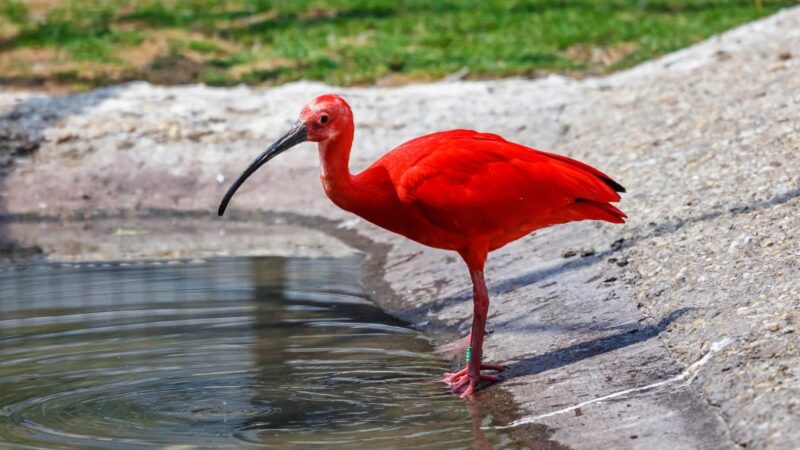
The Scarlet Ibis species are migratory wader birds, often found in tropical South America and the Islands of the Caribbean. These stunning birds are under legal protection, so their numbers are increasing steadily.
The plumage of these exquisite birds is overall scarlet, with a long, curved beak and long legs. These birds have a varied diet that includes crabs, mollusks, small fish, frogs, insects, and worms.
Scarlet Ibis also won’t be a good pet since they can’t thrive in a household setting. They simply love wading in shallow water and foraging in silt and mud, and that’s what they are accustomed to.
Owning these kinds of birds is illegal and can fine you up to $100,000.
- Appearance: Scarlet ibis adults have a bright red color with black-tipped feathers and a dark nib. These wading birds own long, pink legs and partially webbed toes. Scarlet ibis uses their long, curved beak to explore shallow water, mudflats, and grasses to look for food.
- Lifespan: 15 years
- Body Length: 55 cm to 63 cm (22 inches to 25 inches)
- Weight: 1.4 kg (adult)
- Wingspan: 54 cm
- Color: Pink to bright red (scarlet)
- Place of Origin: South America
- Characteristics: The Scarlet Ibis is a friendly bird that lives in flocks comprising thirty or more individuals. These birds search for food together and always protect the young from any threat. In flight, scarlet ibis birds make a V formation, which is a fascinating sight to see.
Pine Grosbeak
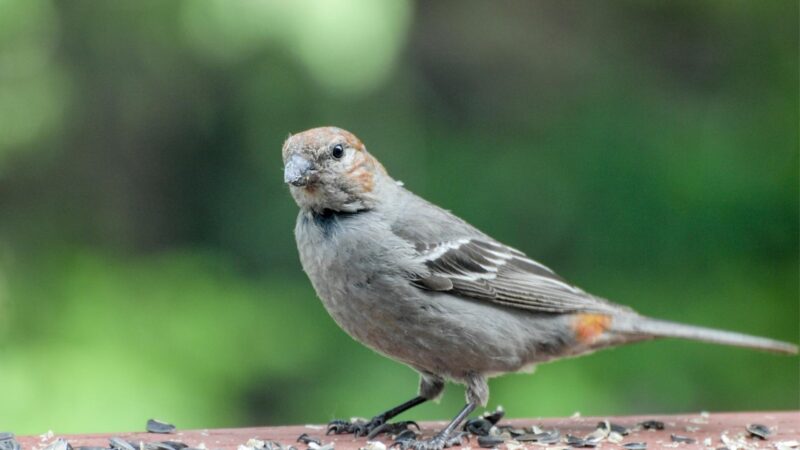
The Pine Grosbeaks are large and plump-chested birds from the Finch family, often seen in subalpine forests. These birds move to the ash forest, maple forest, and mountain ash every winter, getting access to the rich-seed locations.
These birds have various colorations in other parts of America. For instance, in California, they look more orangish, while in the interior West, they emerge in a tint of fading red color.
These birds primarily eat seeds, fruits, buds, and other vegetable matter. These birds are good as pets since they are extremely approachable, playful, lovable, and tamed for wild birds.
- Appearance: The males of pine grosbeak birds are gray and reddish-pink. On the other hand, the females and immatures are grayish in color with yellow or reddish-orange tints on their crowns and tails.
Furthermore, the pine grosbeaks possess dark gray wings with two white wing streaks. The quantity of reddish-pink tint on the male and female bellies, rump, and the head is variable.
- Lifespan: 9 years to 9.5 years
- Body Length: 20 cm to 25 cm (7 inches to 10 inches)
- Weight: 52 grams to 78 grams
- Wingspan: 33 cm
- Color: Gray and reddish-pink (males), grayish with reddish-yellow or orange (females and youngs)
- Place of Origin: Eurasia and North America
- Characteristics: The Pine Grosbeaks have round heads and are bulky and heavy-chested. The bills of these birds are thick and pointed but much stocky than other finch species. On top of that, the tails of these birds are long and slightly jagged.
Scarlet Tanager
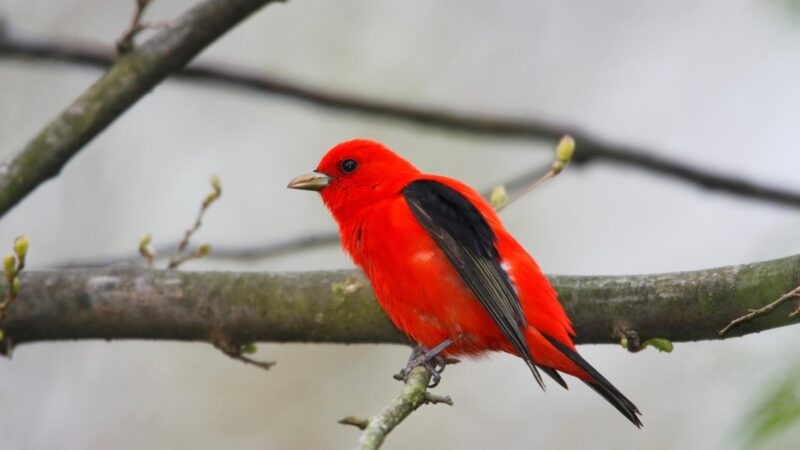
The Scarlet Tanagers are mid-sized, plump songbirds that have round bills, allowing them to eat fruits and insects easily. The males of this species have black wings and red bodies.
Meanwhile, the females’ scarlet tanagers own olive-colored wings and yellow bodies. These birds live in eastern North America’s deciduous-evergreen forests but migrate to lower shrublands every winter.
The diet of these bird species is quite varied, but they feed primarily on most kinds of berries and insects. This includes bees, moths, aphids, caterpillars, and even snails, millipedes, and worms.
Scarlet Tanager is not a popular choice of a pet bird since you have to follow their particular habitat needs and require too much attention to thrive.
- Appearance: Every summer and spring, adult males are particularly distinctive with their brilliant red bodies and black tails and wings. Meanwhile, females and immature own olive-yellow bodies with dark olive wings and tails.
- Lifespan: 12 years
- Body Length: 16 cm to 19 cm (6.3 inches to 7.5 inches)
- Weight: 23 grams to 38 grams
- Wingspan: 25 cm to 30 cm
- Color: Brilliant red for males and olive-yellow for females
- Place of Origin: Eastern North America
- Characteristics: Scarlet Tanagers possess olive-yellow colors for females and brilliant red colors for males. These gorgeously colored birds spend most of their time skulking in the forest canopy of broad deciduous trees’ leaves.
Red Crossbill
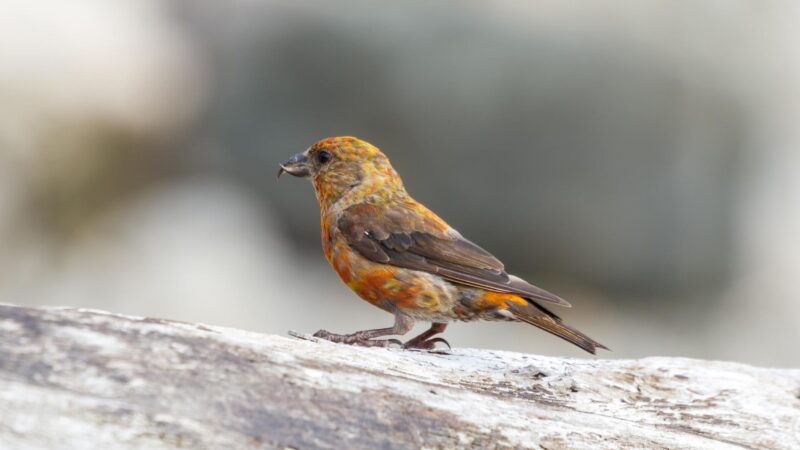
The Red Crossbill is a medium-sized songbird known for its unique bill that typically has twisted edges. Males of this species have brick-like color bodies with medium-sized tails and dark wings.
On the other hand, red crossbill females own nearly olive-brown bodies with yellow bottoms. Their diet involves conifer seeds, sunflower seeds, berries, aphids, etc.
Since these birds thrive in small flocks, they won’t make good pets if you are only thinking of getting one as a pet.
- Appearance: The adult red crossbill males own brick-red bodies with dark tails and wings. Females predominantly have olive-brown bodies and yellowish bottoms. In addition, immatures have brownish bodies with a pale brownish band at the bottom.
- Lifespan: 2 years to 5 years
- Body Length: 14 cm to 16 cm
- Weight: 29 grams to 43 grams
- Wingspan: 25 cm to 27 cm
- Color: Redbrick for adult ales and yellowish-brown for adult females
- Place of Origin: Northern Hemisphere
- Characteristics: Red crossbill males are typically red overall with much darker wings, while females possess olive-brown bodies and the same wings color as the males.
Northern Cardinal
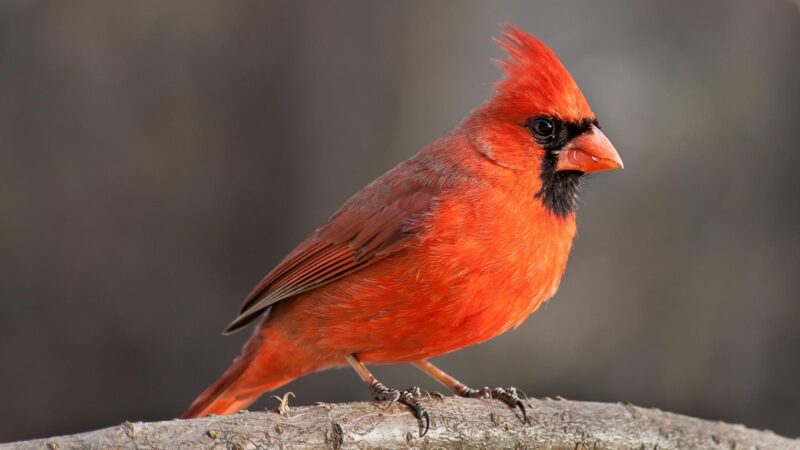
The Northern Cardinals are also known as Virginia Nightingale and Redbird. These bird species can be distinguished easily from the other cardinals by looking at their prominent head crest and bright red plumage.
Another notable attribute of these birds is their melodic songs, the reason they are often called nightingales. These birds mostly feast on insects, including grasshoppers, beetles, caterpillars, true bugs, spiders, snails, centipedes, etc.
On top of these foods, they also consume leaf buds, flowers, waste grains, most berries, and wild fruits. If you are from Japan, Russia, or Northern America, you can’t keep these birds as pets since they are protected under the Migratory Bird Treaty Act Law.
That means selling, owning, or trading these birds and they’re over 1,000 other native species will make you face a $15,000 fine.
- Appearance: The male cardinals have that brilliant red look with a rosy snout and black face. Meanwhile, female cardinals own pale brown bodies, with warm reddish traces in their crests, tails, and wings. Both sexes have identical red-orange bills and black faces.
- Lifespan: 3 years to 5 years
- Body Length: 21 cm to 23 cm (8.3 inches to 9.1 inches)
- Weight: 33 grams to 63 grams
- Wingspan: 25 cm to 31 cm
- Color: Brilliant red for males and pale brown with red traces for females
- Place of Origin: Canada
- Characteristics: Northern cardinals are very active, medium-sized songbirds that can sing various melodies. It’s best to note that male cardinals can become aggressive when protecting their domain and often attack other males who infringe on their areas.
Painted Whitestart
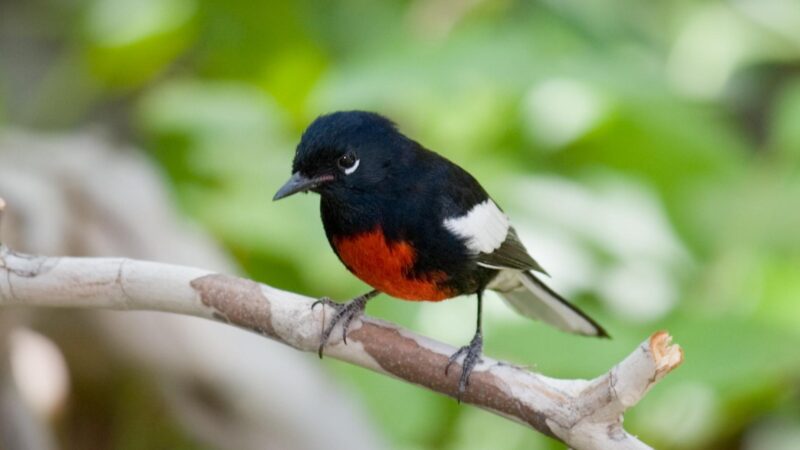
The painted whitestart is a New World warbler species encountered in mountainous regions of inland Central America. These birds are among the biggest warblers reaching six inches long, including the tails.
These birds are primarily found in Central America and Mexico. However, their Northern extent ranges into Arizona and New Mexico.
Painted whitestars are insectivores, which means they primarily feed on various insects, including small beetles, caterpillars, and flies. Since these birds are mostly found in mountainous areas, they can hardly be seen as pets for sale.
- Appearance: Adult painted whitestarts have lustrous black plumage with bright red bellies and white strips on their wings. Both sexes have identical appearances.
- Lifespan: 7 years
- Body Length: 15 cm
- Weight: 5.9 grams to 9.6 grams
- Wingspan: 21 cm
- Color: Black with white band and red belly
- Place of Origin: Central America
- Characteristics: Painted whitestarts are active foragers, moving fast via limbs or along the ground. When in flight, these birds occasionally drift and extract insects from vegetation and fly out to grab insects mid-air.
Crimson-Collared Grosbeak
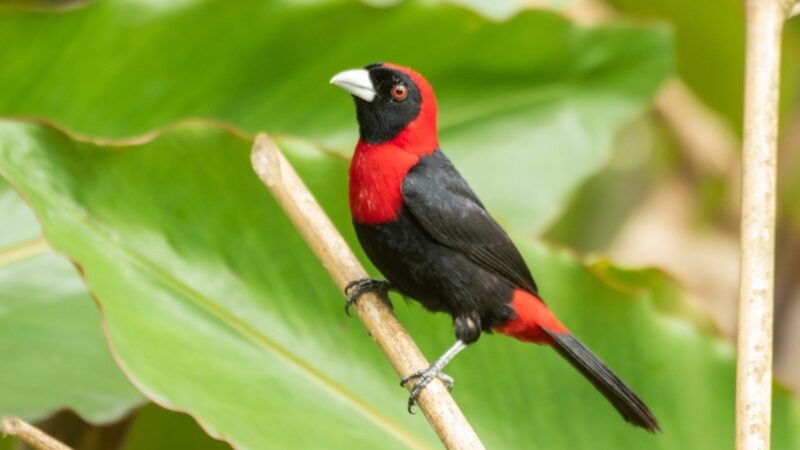
These herbivore birds are commonly seen in Northeastern Mexico and are native to North America. Crimson-Collared Grosbeak birds are migratory, usually moving to Texas when winter comes.
These birds are usually found in woodland edges, forested areas, and bushy thickets.
When feeding on fruits and leaves, they can be sedentary, staying in one location and occasionally eating. It’s not known if these birds can be kept as pets.
- Appearance: The male Crimson-Collared Grosbeak owns a blackish face, throat, tail, and wings. Their collar is crimson-red with two narrow streaks on their wings. Meanwhile, females are predominantly olive-green but with black throats and faces. Both sexes have a relatively large black bill.
- Lifespan: 6 years
- Body Length: 13 cm to 15 cm
- Weight: 8 grams to 12 grams
- Wingspan: 21 cm
- Color: Blood-red bodies with blackish-red backs
- Place of Origin: Northeastern Mexico
- Characteristics: Crimson-Collared Grosbeak mature males possess black plumage with a pinkish-red to light red collar on the nape, belly (with black spots) and shoulders.
Apapane
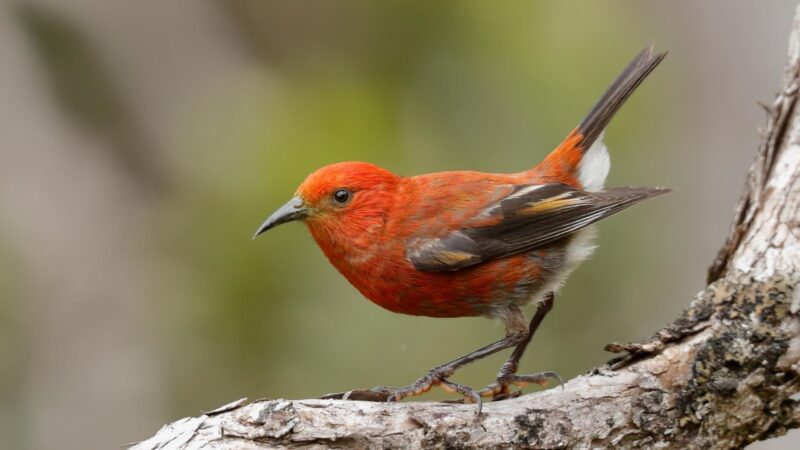
The Apapane have bright crimson feathers used by the native Hawaiians to embellish helmets, capes, and feather wreaths of Hawaiian nobility.
The Apapane can be found on Maui, Big Island, Kauaʻi, Lanaʻi, Oʻahu and Molokaʻi. Nonetheless, 80 percent of these birds’ population emerges on the Big Island.
These birds have brush-tipped tongues perfect for sipping nectar and heavily rely on ‘ohi‘a flowers’ nectar. Apapane birds roam widely on their home islands, succeeding in the blooming of native trees’ patterns.
Apapane mostly feeds on nectars and a variety of insects, slugs, seeds, fruits, tree sap, seed pods, spiders, and more. Though it’s not common to keep these birds as pets, it is not illegal to have them as pets.
However, it’s best to know that they will require extra attention and care as pets just like other rare bird species. The cost of this species is not generally known.
- Appearance: Adult Apapane males and females are identical in appearance. Both sexes have crimson-red feathers, noticeable white feathers underneath with black wings, curved snouts, and tails.
- Lifespan: 9.5 years
- Body Length: 20 cm to 25 cm (7 inches to 10 inches)
- Weight: 52 grams to 78 grams
- Wingspan: 33 cm
- Color: Crimson red (adults), yellow-brown to grayish-brown for Juveniles
- Place of Origin: Hawaii
- Characteristics: The adult Apapane birds are crimson red in color except with dark wings, tails, and white vents. Their bills are relatively short and slightly bent.
House Finch
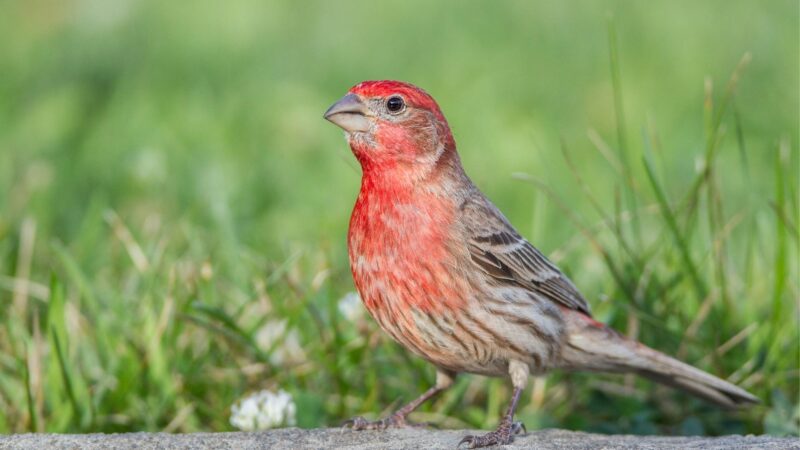
House Finches are adaptable, small-bodied birds with relatively large beaks and rather long, flat heads. Their wings are short, causing their tails to appear longer.
The crown, breast, and tail of house finches are red, while the rest of their bodies are a muted tint of light brown. But, it’s best to note that male House Finch color can vary from red to orange or yellow due to their varied diet.
Nonetheless, they primarily feed on weed seeds and vegetable matter. These birds also consume aphids, buds, and flowers.
These birds are ideal to be kept as pet birds since they are very social. However, it’s best to note to get two or more individuals of this species since they usually thrive in flocks.
This bird costs around $20 to $75 above, depending on age, species, and ultimately the person from whom you are buying it.
- Appearance: Male adult house finch has rosy red upper breast and face, with banded brown back, tail, and belly. During their flight, the red rump of this bird is very noticeable. The adult females of this species are not red but are grayish-brown with blurry lines and an indistinguishably marked face.
- Lifespan: 9 years to 10 years
- Body Length: 5 inches to 6 inches
- Weight: 16 grams to 27 grams
- Wingspan: 20 cm to 25 cm
- Color: Rosy red with brownish back, abdomen, and tail (adult males), grayish-brown (adult females)
- Place of Origin: The Western United States and Mexico
- Characteristics: House Finches are social birds collecting seeds at feeders. When these birds are not at feeders, they typically feed on weed stalks, trees, or grounds.
Painted Bunting
When you see a Painted Bunting, it will look like it came out straight from a coloring book. Its color is a blend of beautiful hues, such as blue, red, and green for males and bright yellow-green for immatures and females.
These beautifully social yet secretive birds love to hide in bushes and sing their honey-like melodies. Painted Buntings are commonly found in the Southeast Woodlands, comprising the states of Alabama, some areas of Florida, Georgia, and Louisiana.
The diet of these birds is mostly, but not limited to weed seeds and insects, which include caterpillars, flies, grasshoppers, beetles, etc. Painted Buntings also occasionally consume various berries and fruits.
Owning, distributing, or selling these birds are illegal in the United States. However, if you have the pure intention of taking care of these birds, you can apply for a license to rehabilitate these birds.
- Appearance: Males have stunning colors of blue heads, red underparts, and green backs. Females and immatures are uniforms, bright yellow-green overall, with a pale eyering.
- Lifespan: 11 years
- Body Length: 12 cm to 14 cm (4.7 inches to 5.5 inches)
- Weight: 13 grams to 19 grams
- Wingspan: 21 cm to 23 cm
- Color: A mix of blue, red, and green for males and a bright yellow-green with pale eyering for females
- Place of Origin: North America
- Characteristics: Painted buntings are shy and secretive birds. They are often hard to observe since they love to hide while singing melodious tunes. Nonetheless, these birds are relatively approachable and are accustomed to bird feeders.
Purple Finch
The Purple Finch bird species is not a pure red color but pinkish red. These birds have rosy-red heads, breasts, and underparts.
Although they are named purple finch, the color they possess is not purple but a rosy red color. Unlike the house finches, the purple finches like to occupy areas with a lesser human population.
They are primarily found in shrublands, deciduous or coniferous forests, and old fields. These birds primarily eat various seeds of trees, including elm, ash, and even grass and weed seeds.
As pets, purple finches can be interactive but can still be aggressive at some point. You also have to consider getting two or more finches so that these birds would thrive under your care since they are, after all, social birds.
You can purchase this bird species at a price ranging from $50 to $150 each.
- Appearance: Male Purple Finches have delicate pink-red on their heads and breasts with brown back and hazy white on the bellies. Meanwhile, female purple finches have no red with a coarse band underneath.
In addition, these birds have intense facial markings, including a whitish eyestripe and a dark streak down the throat’s side.
- Lifespan: 5 years to 9 years
- Body Length: 12 cm to 16 cm
- Weight: 34 grams
- Wingspan: 22 cm to 26 cm
- Color: Pink-red with a mix of brown and white
- Place of Origin: Canada and the Northeastern United States
- Characteristics: Purple finches are very noticeable birds due to their pinkish-red color, straddling usually in treetops and singing frequently.
White-Winged Crossbill
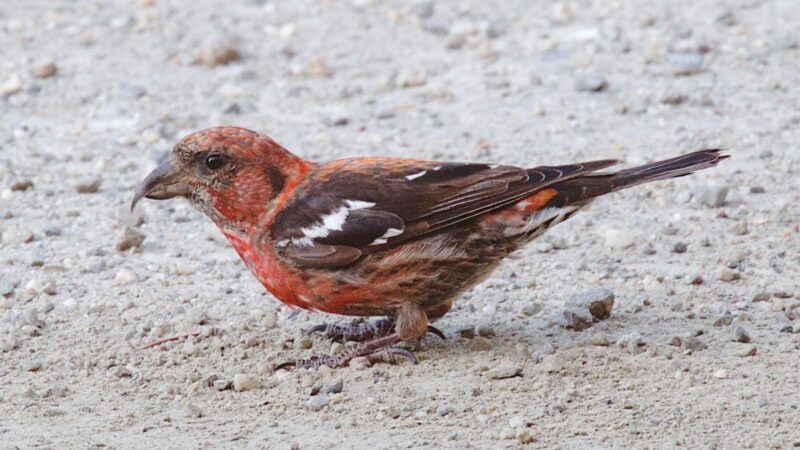
White-winged crossbills are medium-sized plump birds with unique crisscrossed bills. They have overall red bodies with black wings with white-winged bars, working as a field mark for bird-watchers.
These birds visit the Boreal forests and can be seen in your yard bird feeders periodically. They are very social animals and live in flocks all year round, including during the nesting season, which falls in spring.
Unlike males, females have yellowish bodies with the same tails and wings pattern. In terms of diet, these birds primarily feed on conifer, spruce, hemlock, and tamarack seeds. In addition, the white-winged crossbills also feed on various insects, buds, berries, and weed seeds.
These birds are illegal to own, so you can’t keep them as pets.
- Appearance: White-winged crossbill adult males are rose-pink in color with black tails and wings and two white wing streaks. Youngs and females are yellowish in color but with the same tail and wing pattern.
- Lifespan: 4 years
- Body Length: 15 cm to 17 cm
- Weight: 24 grams to 26 grams
- Wingspan: 26 cm
- Color: Rose-pink
- Place of Origin: Northern Scandinavia to Siberia
- Characteristics: White-winged Crossbills are medium-sized crossbills with bright pink bodies except for their black wings with two prominent white wing streaks. These birds usually start nesting in late winter and have been documented nesting year-round, whenever food is abundant.
Summer Tanager
The Summer Tanager is among the most impressive songbirds breeding in North America. While the females own mustard-yellow bodies and green wings, the males possess bright red hues around their bodies.
You can witness these birds straddling the willow, pine, and oak trees. Every winter, most of these little birds migrate to Mexico and as far as Brazil and Bolivia.
These birds have a varied diet, composed mainly of insects that include caterpillars, beetles, bees, wasps, cicadas, flies, bugs, and spiders. These birds also occasionally feed on small fruits and berries.
Though Summer Tanagers are exceptionally beautiful birds, they can’t be kept as pets since it’s illegal to have them. Also, they don’t do well in a regular home setting.
- Appearance: Adult male Summer Tanagers have a completely bright red color. Meanwhile, females and young males own bright yellow-green to yellowish color underparts and heads. Their backs and wings are somewhat greener with pale bills. Molting young males can have patchy red and yellow colorings.
- Lifespan: 4 years to 6 years
- Body Length: 17 cm
- Weight: 29 grams
- Wingspan: 11 inches to 11.5 inches
- Color: Bright red for males, bright yellow-green for females
- Place of Origin: North of Mexico
- Characteristics: Summer tanagers are typically solitary bird species. Males can be aggressive when defending their nest and feeding domain during the breeding season.
After these birds reach the breeding grounds, males contend for territory and safeguard their domain by singing and chasing out other males.
Red-Breasted Sapsucker
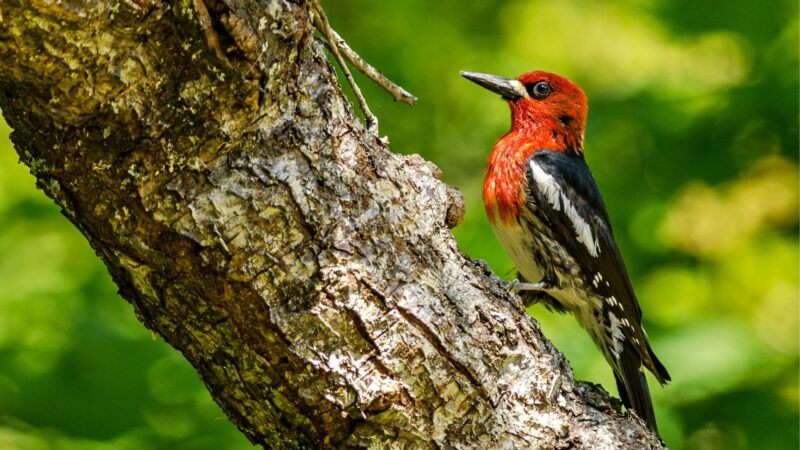
The Red-breasted Sapsuckers are woodpeckers that came from the sapsucker family. They have an erect stance and stout snoot.
Their head, breast, and neck have a bright red hood covering and a muted yellow shade underneath their bodies. These birds frequently nest on the hemlock, ponderosa pine trees, and aspen in the coniferous and deciduous forests of the United States.
The diet of Red-breasted Sapsuckers is mainly tree sap, berries, insects, and fruits. It’s best to note that these birds can’t be kept as pets since it is illegal to own them.
These birds are protected under the Federal Migratory Treaty Act of 1918 which protects all the woodpeckers’ species, to which the Red-breasted Sapsucker belongs.
- Appearance: Both sexes of Red-breasted Sapsuckers have redheads and breasts. These birds also have a white spot that can be located between the eye and the beak. The back of these birds is spotted in black and white. On top of that, their wings are colored black with a large upright white patch.
- Lifespan: 2 years to 3 years
- Body Length: 7 inches to 9 inches
- Weight: 59 inches to 65 inches
- Wingspan: 14 inches to 16 inches
- Color: Redhead and breast with white spots on bills and in-between the eyes
- Place of Origin: British Columbia, Southeast Alaska, and Pacific Coast
- Characteristics: Red-breasted Sapsuckers love to sunbathe every mid-day hours and are highly territorial, especially during the breeding season.
Vermilion Flycatcher
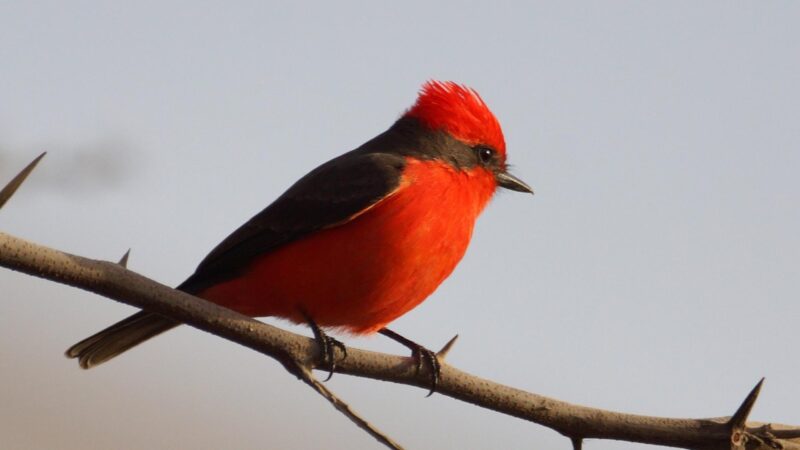
The Vermilion Flycatcher is the most stunning member of the despot flycatcher family. While other flycatchers seem to be dull, the bodies of these spectacular birds are wrapped in a deep shade of red.
These birds prefer to stay close to bodies of water and submerge their tails. Hence, you can mostly find these birds at the edge of streams, ponds, and lakes.
The Vermillion Flycatcher diet includes grasshoppers, flies, honey bees, beetles, and crickets. These birds won’t make a good pet since they mostly thrive only in woodland, savanna, and desert areas.
- Appearance: Adult males own a bright orange-red coloring with a dark brown cover and brown wings, backs, and tails. Females and young are usually grayish-brown with faint bars on the breast and a salmon-red blush on the underneath. The bill of both sexes is black.
- Lifespan: 5 years to 5.5 years
- Body Length: 13 years to 14 years
- Weight: 11 grams to 14 grams
- Wingspan: 9.4 inches to 9.8 inches
- Color: Bright-orange for males and gray-brown for females
- Place of Origin: The Southwestern United States to the South and Northern Chile
- Characteristics: Vermilion flycatchers are typically solitary birds. However, these noticeable birds can create small flocks of not over five individuals during winter.
Pyrrhuloxia
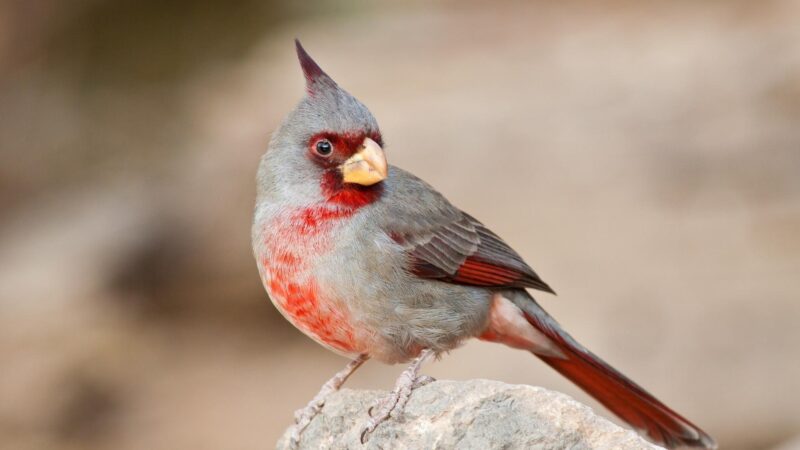
Pyrrhuloxia, also called desert cardinal, typically lives in the dry parts of Southwest America. These birds predominantly forage on the ground, trees, and shrubs.
Their diet is varied, which includes various insects like arthropods, caterpillars, beetles, grasshoppers, etc. Pyrrhuloxia also feeds on various seeds of weeds, grasses, and mesquite, along with berries and wild fruits.
Since these birds are wild creatures, they are hardly kept as pets in a traditional sense. With that said, it is not legally possible to get this species as a pet bird.
- Appearance: The pyrrhuloxia is comparable to the northern cardinal in terms of looks. Males are gray with red wings and tails, a rosy red breast, face, and crest. Meanwhile, females are a little paler in color and lack red faces and breasts.
- Lifespan: 8 years
- Body Length: 8.3 inches
- Weight: 42 grams
- Wingspan: 10 inches to 12 inches
- Color: Gray and red
- Place of Origin: American Southwest and Northern Mexico
- Characteristics: In general, Pyrrhuloxias have a gray to a grayish-brown color with prominent glints of red. Males are usually crisp gray with a red crest and face, a reddish tail, and a red streak steering down their breasts. Females have lesser red colorings than males, but both sexes have reddish wing highlights and yellowish bills.
Elegant Trogon
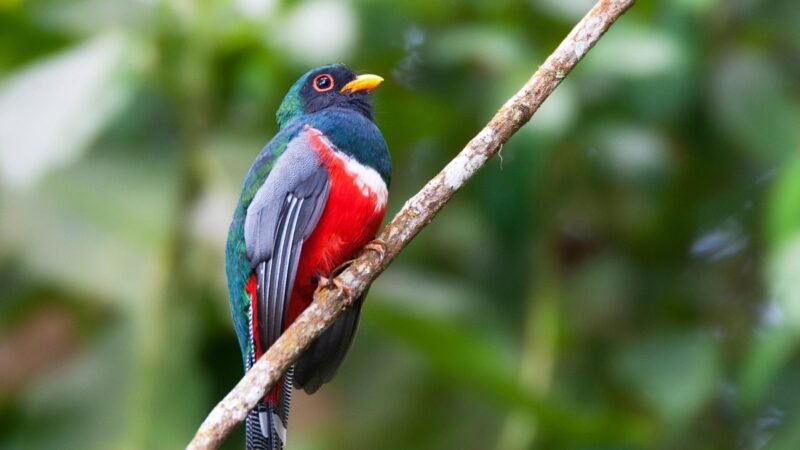
Coppery-tailed trogon was the initial name of the Elegant Trogon. These birds typically live in the tropical woodlands of North America.
These birds own metallic green heads with a white line, marking the difference between the head part and the underbody—usually bright red in color.
As omnivores, these birds usually feast on various fruits, small animals, and insects, including moths, caterpillars, cicadas, grasshoppers, and more.
These birds won’t make excellent pet birds since these are wild birds that prefer their own natural habitat.
- Appearance: Elegant Trogons are intelligent bird species with rose-red underparts and coppery green upper parts. These birds have a white streak across their breasts and a black-and-white striped bottom to the tail.
- Lifespan: 4 years
- Body Length: 32 cm
- Weight: 210 grams
- Wingspan: 16 inches
- Color: Copper-green upperparts and rose-red lower parts
- Place of Origin: North America
- Characteristics: Elegant Trogons are brilliant birds that prefer to build their nests along streams and cavities of either live or dead trees. Nonetheless, these birds rely primarily on the holes that woodpeckers made or even reused the nests from past years.
Summary
So, there you have it—the 18 birds with red breasts! If you are currently looking for birds with red breasts, you can refer back to this guide anytime to determine which one is best suited for you.
List of Sources
Scarlet Ibis to be designated an Environmentally Sensitive Species. Government of the Republic of Trinidad and Tobago.
Ivory, A. (2002). Piranga rubra. Animal Diversity Web.
Woodlands. Smithsonian National Museum of the American Indian.
Coady, G. (2001). First Nest Record of White-winged Crossbill in the Greater Toronto Area. The University of New Mexico.
